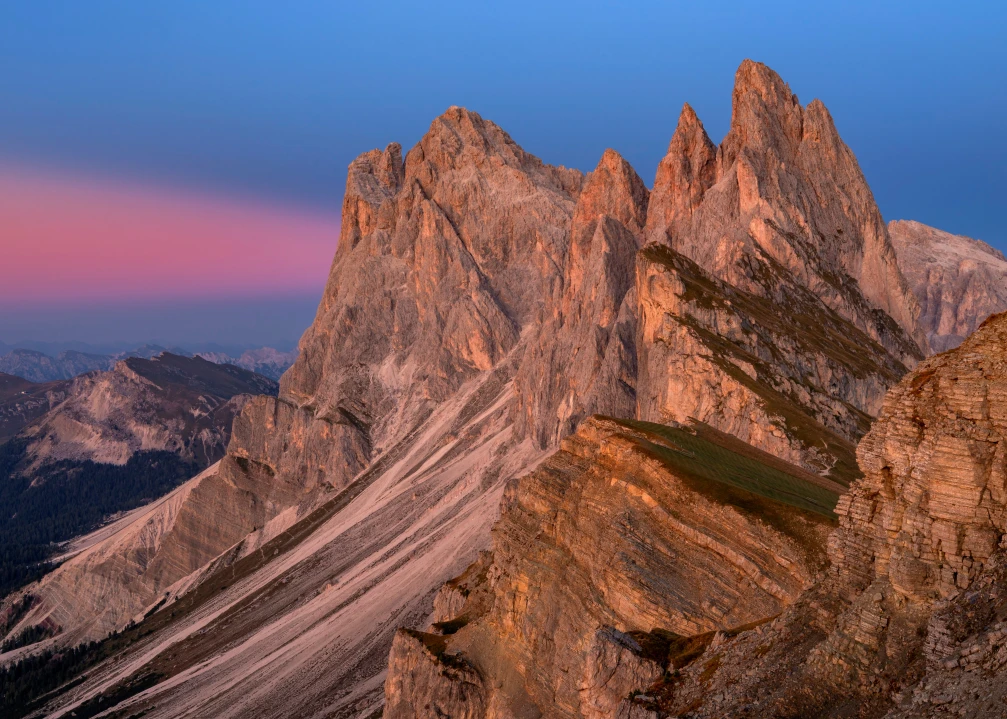The Dolomites constitute the eastern part of the Alpine Mountain Range, and are one of the 55 Italian sites on the UNESCO World Heritage List. The zone recognized as composing UNESCO covers 141,903 hectares and three regions (Trentino Alto Adige, Veneto and Friuli Venezia Giulia) and five provinces (Trento, Bolzano, Belluno, Pordenone and Udine); it also includes 18 peaks that rise over 3,000 meters (9,843 feet).
The mountainous groups included run from the Brenta Dolomites to the Catinaccio and the Latemar, between the Alto Adige and the area of Trento; from the Dolomites of Sesto to the Pale di San Martino; from the massif of Marmolada to the group composed of Pelmo and Croda da Lago, to then arrive at the Friulian Dolomite chain, the most eastern of them all.
Le Corbusier, one of the most noted architects of the 1900s, defined them as the “most beautiful architectonic work in the world.”
And indeed, the Dolomites offer up a magnificent panorama: mountains constructed with walls of rock, ice caps, karst systems, unbelievably high spires, towers and pinnacles – mountains molded and shaped by the elements, and where the cultures of Italy, Germany and the native Ladin community all meet and intertwine.
The Dolomites take their name from the French geologist Dieudonné Dolomieu, who discovered the properties of the dolomite, a hard, chalky rock that is rich in the mineral dolomite, highly present in this mountain system. The rock evidently gives to the mountains a very distinct white cast (which is why they are also called the “Pale Mountains”), but the most particular tones arise every evening when the sun starts to set: the colors go from pinkish hues to fiery reds, the phenomenon referred to as Alpenglow.
This entire process can be explained by the fact that up until 250 million years ago, these mountains were a mass of shells, corals and algae under the sea. They emerged only 70 million years ago. It is this combination of circumstances that make these structures, rich in Mesozoic fossils, the amazing geological formations that they are.
Sport, Ski and Nature in the Dolomites
The chain’s westernmost appendage is the Brenta Group, where one finds the epitome of mountain tourism: Madonna di Campiglio. Also known as the "Queen of the Dolomites," the famous locality of Pinzolo, situated in the Val Rendena, is one of the most important ski hubs nationally. Pinzolo also boasts more than 37 miles of slopes and 20 ski lifts. The 3-Tre Slope is a favorite: this name refers to the "Three Races of Trentino," where special slalom contests take place during the World Cup of Alpine Skiing. H
However, the Dolomites officially begin east of Trento, where lies the ski district between Val Cismon and the Valleys Fiemme and Fassa, and where San Martino di Castrozza, Predazzo, Cavalese, and the communities of Moena and Canazei meet, surrounded by the summits of Mounts Sella, Sassolungo and Marmolada.
In the northernmost section, in the Province of Bolzano, Val Gardena – bordered on its north by the Siusi Alps – offers fascinating displays of nature amidst the prestigious Ortisei and the elegant Santa Cristina and Selva. Here one can find the Sasslong, one of the most famous ski slopes in the entire world, where the World Cup in Freestyle Skiing is held every yea - it is, after all, one of the most spectacular alpine freestyle ski descents around.
Beyond the Sella Pass, Val Badia extends over the gems of the Ladin community, comprising characteristic San Cassiano, La Villa and Corvara. Once having crossed the Falzarego Pass, one will see Arabba, sitting on the border between the regions of Veneto and Alto Adige. Beneath the Plan de Corones is the Isarco Valley, which Bressanone does a fine job of embellishing, and the Pusteria Valley, with the villages of Brunico and San Candido.
Between Alto Adige and the Veneto, the silhouettes of the Three Peaks of Lavaredo stand out – along with Monte Cristallo, they hover over the “Pearl of the Dolomites,” that is Cortina d’Ampezzo and its neighboring Valleys of Comelico and Cadore. Host to the 1956 Winter Olympic Games and defined solely in the terms of chic and ski, Cortina is a glitzy, glam symbol both on the Italian and international scenes. It has always been a top destination for mountain and nature enthusiasts, as well as those in search of winter sport activity and, in general, fun.
At the base of the National Park of the Bellunesi Dolomites (that extends all the way to Feltre), the imposing Marmolada, Monte Civetta and Pale di San Martino rise, with the nearby hub of Agordo, an international destination for Alpine skiing.
On the Dolomites' northeastern edge, between the Province of Udine and Pordenone, is the beautiful and evocative Regional Park of the Friulian Dolomites.
Among the Trentino and Alto Adige ski hubs, mostly located in Val di Fassa, Val Gardena and Val Badia, Dolomiti Superski, the largest ski district internationally, allows skiers to reach some of the most famous and best-equipped slopes in the Dolomites. This even includes the wild and fascinating zones of the Friulian Dolomites like Valcellina,the Valle del Tagliamento, Val Colvera and Val Tramontina, all ideal for trekking and nature excursions.




